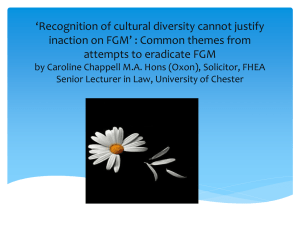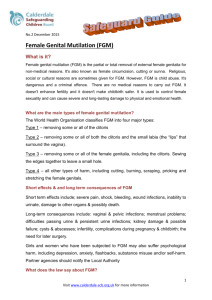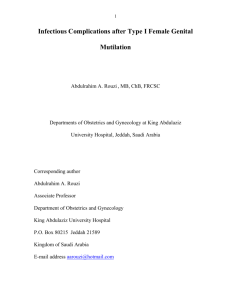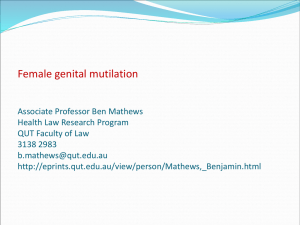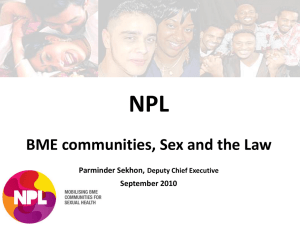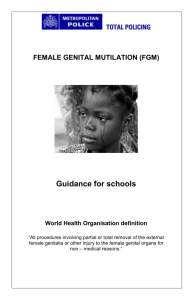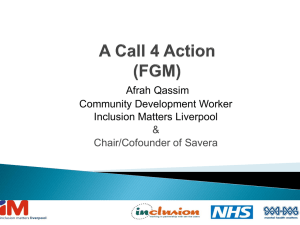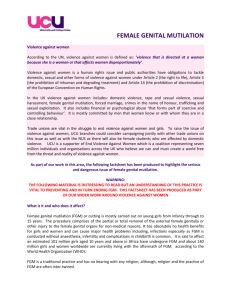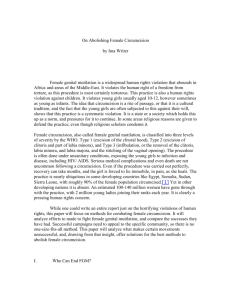FGM
advertisement
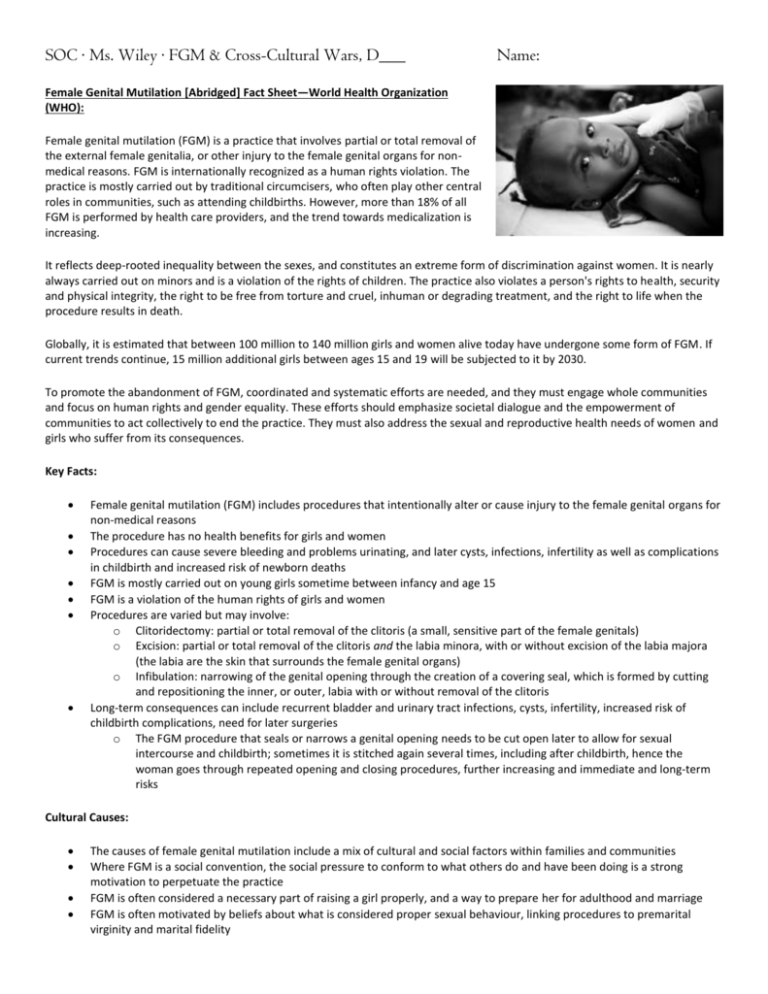
SOC ∙ Ms. Wiley ∙ FGM & Cross-Cultural Wars, D___ Name: Female Genital Mutilation [Abridged] Fact Sheet—World Health Organization (WHO): Female genital mutilation (FGM) is a practice that involves partial or total removal of the external female genitalia, or other injury to the female genital organs for nonmedical reasons. FGM is internationally recognized as a human rights violation. The practice is mostly carried out by traditional circumcisers, who often play other central roles in communities, such as attending childbirths. However, more than 18% of all FGM is performed by health care providers, and the trend towards medicalization is increasing. It reflects deep-rooted inequality between the sexes, and constitutes an extreme form of discrimination against women. It is nearly always carried out on minors and is a violation of the rights of children. The practice also violates a person's rights to health, security and physical integrity, the right to be free from torture and cruel, inhuman or degrading treatment, and the right to life when the procedure results in death. Globally, it is estimated that between 100 million to 140 million girls and women alive today have undergone some form of FGM. If current trends continue, 15 million additional girls between ages 15 and 19 will be subjected to it by 2030. To promote the abandonment of FGM, coordinated and systematic efforts are needed, and they must engage whole communities and focus on human rights and gender equality. These efforts should emphasize societal dialogue and the empowerment of communities to act collectively to end the practice. They must also address the sexual and reproductive health needs of women and girls who suffer from its consequences. Key Facts: Female genital mutilation (FGM) includes procedures that intentionally alter or cause injury to the female genital organs for non-medical reasons The procedure has no health benefits for girls and women Procedures can cause severe bleeding and problems urinating, and later cysts, infections, infertility as well as complications in childbirth and increased risk of newborn deaths FGM is mostly carried out on young girls sometime between infancy and age 15 FGM is a violation of the human rights of girls and women Procedures are varied but may involve: o Clitoridectomy: partial or total removal of the clitoris (a small, sensitive part of the female genitals) o Excision: partial or total removal of the clitoris and the labia minora, with or without excision of the labia majora (the labia are the skin that surrounds the female genital organs) o Infibulation: narrowing of the genital opening through the creation of a covering seal, which is formed by cutting and repositioning the inner, or outer, labia with or without removal of the clitoris Long-term consequences can include recurrent bladder and urinary tract infections, cysts, infertility, increased risk of childbirth complications, need for later surgeries o The FGM procedure that seals or narrows a genital opening needs to be cut open later to allow for sexual intercourse and childbirth; sometimes it is stitched again several times, including after childbirth, hence the woman goes through repeated opening and closing procedures, further increasing and immediate and long-term risks Cultural Causes: The causes of female genital mutilation include a mix of cultural and social factors within families and communities Where FGM is a social convention, the social pressure to conform to what others do and have been doing is a strong motivation to perpetuate the practice FGM is often considered a necessary part of raising a girl properly, and a way to prepare her for adulthood and marriage FGM is often motivated by beliefs about what is considered proper sexual behaviour, linking procedures to premarital virginity and marital fidelity FGM is in many communities believed to reduce a woman's libido and therefore believed to help her resist "illicit" sexual acts FGM is associated with cultural ideals of femininity and modesty, which include the notion that girls are “clean” and "beautiful" after removal of body parts that are considered "male" or "unclean" Though no religious scripts prescribe the practice, practitioners often believe the practice has religious support Religious leaders take varying positions with regard to FGM: some promote it, some consider it irrelevant to religion, and others contribute to its elimination Whether it is seen as marking the transition from girlhood to womanhood, symbolically protecting a woman’s honor, restraining her sexual urges, or increasing her chances of finding a husband, FGM is rooted in societal notions of honor and tradition International Response: Since 1997, great efforts have been made to counteract FGM, through research, work within communities, and changes in public policy. Progress at both international and local levels includes: wider international involvement to stop FGM; international monitoring bodies and resolutions that condemn the practice; revised legal frameworks and growing political support to end FGM (this includes a law against FGM in 24 African countries, and in several states in two other countries, as well as 12 industrialized countries with migrant populations from FGM practicing countries); in most countries, the prevalence of FGM has decreased, and an increasing number of women and men in practising communities support ending its practice. In December 2012, the UN General Assembly adopted a resolution on the elimination of female genital mutilation. An African Perspective on Female Circumcision, Association of African Women for Research and Development (AAWORD): 1. What is the basis of the authors’ assertion that critics of female circumcision are guilty of “latent racism”? 2. According to the authors, how have Western criticisms of female circumcision hindered the efforts of African critics to limit the practice? 3. In the view of the authors, what would be an appropriate Western approach to the issue of female circumcision? 4. How might an ardent Western critic of female circumcision in Africa counter the arguments contained in the AAWORD statement? [Excerpts from] The Eastern Myth of Western Women, The Guardian, 2010: Unflattering as some western stereotypes are of eastern women, particularly Arab, western women also get a bad press in conservative eastern circles. . . . [W]estern women hover somewhere between myth and fantasy in the eastern world. "They’re loose, obsessed with sex, bad mothers, and can't cook.” Eastern views of the contemporary western woman are highly sexualised. In this view, western women are oversexed, promiscuous and have revolving doors in their knickers. What is behind this belief that western women are somehow sex-crazed? Part of it relates to the conservative fixation on women's sexuality in general. According to this outlook, women's sexual appetites are so insatiable that, if they are left to their own devices, they turn into uncontrollable nymphomaniacs and temptresses luring men to crash into the rocks of lust. (Such stories are evident in most religious texts, including the Bible and Koran.) It should be pointed out that many religious Arabs, including women, do not believe that Arab women are oppressed, but that they enjoy a different, and superior, kind of liberty. In an interesting turning of the tables, conservatives are reciprocating the western interest in the position of Arab and Muslim women by examining the "oppressed" status of the western woman. A conservative Islamic site targeted at women asks "who will end the injustice against western women? How can they [the west] demand the ending of what they see as injustice against Saudi women, when their own women are drowning in seas of injustice?" The site speaks to the prevalence of domestic violence, rape, eating disorders, objectification in the media, pornography, prostitution, plastic surgery, etc., in the west. 5. Do you think that the stereotype of western women in the eastern world has any truth to it? Why or why not? If so, is that something that needs to be addressed as a social problem? Why or why not? 6. What is your reaction to the argument that western women are oppressed? To what extent is it true?

